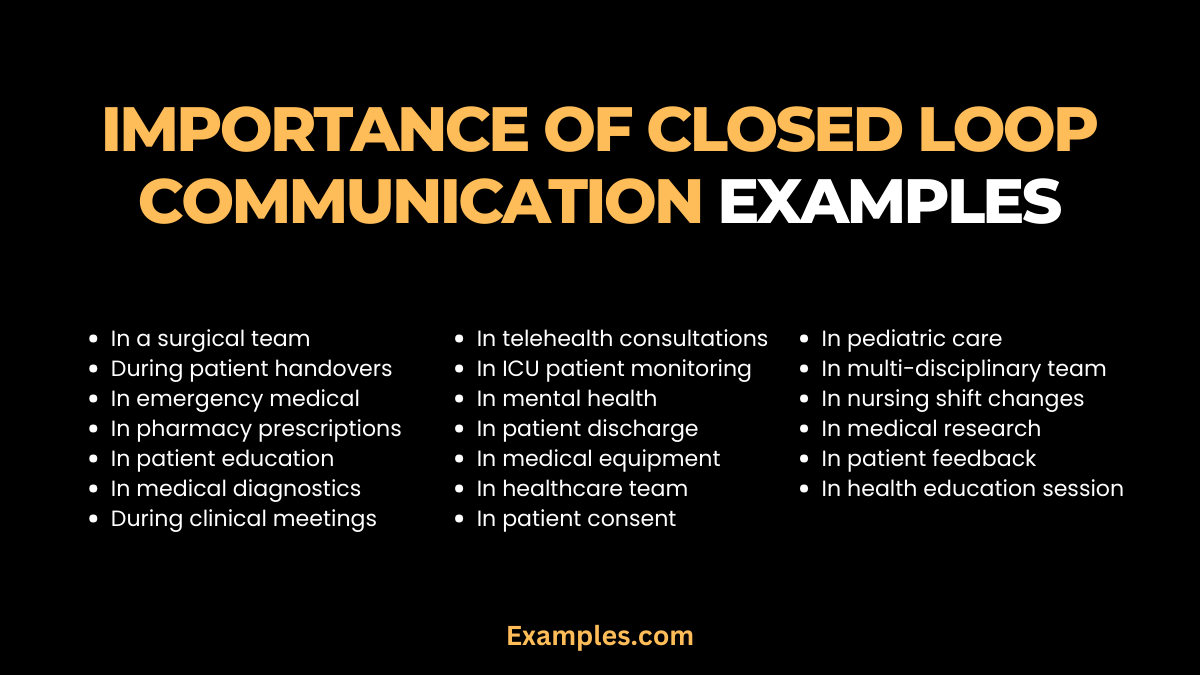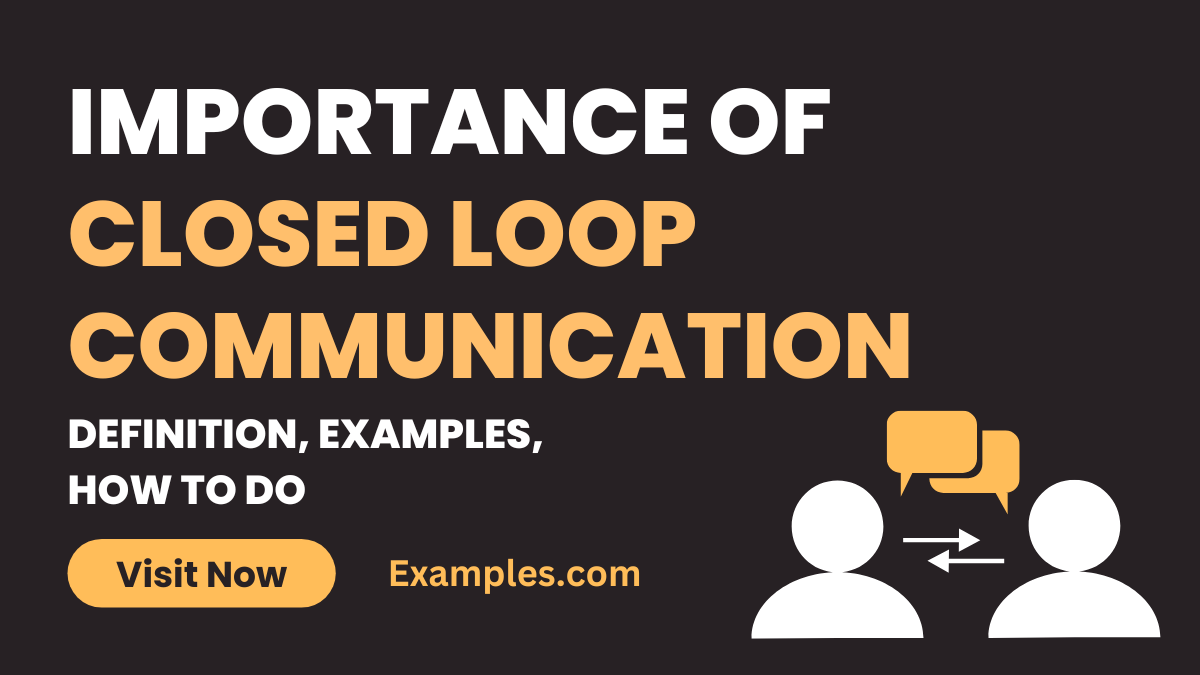Importance of Closed Loop Communication
Closed Loop Communication is a fundamental communication technique that plays a critical role in ensuring clarity and accuracy, particularly in healthcare settings. This comprehensive guide explores the Importance of Closed Loop Communication, providing practical examples to illustrate its application. Understanding What is Closed Loop Communication and implementing the Essential Actions for Closed Loop Communication can significantly enhance patient safety, reduce medical errors, and improve overall healthcare efficiency. Through real-life scenarios and examples, this guide will demonstrate how Closed Loop Communication is implemented in various medical settings and its impact on patient care and healthcare team coordination.
What is the Importance of Closed Loop Communication? – Meaning

The importance of Closed Loop Communication lies in its ability to ensure clear, accurate, and efficient exchange of information, particularly in healthcare settings. This communication process involves specific steps, known as Closed Loop Communication Steps, where information is not only transmitted but also acknowledged, clarified, and confirmed back to the sender. In healthcare, Closed Loop Communication in Healthcare is crucial for patient safety, reducing medical errors, and enhancing team coordination. It ensures that every team member precisely understands patient care instructions and procedures, significantly contributing to the quality of care and patient outcomes.
Download Importance of Closed Loop Communication in PDF
20 Importance of Closed Loop Communication Examples

The “Importance of Closed Loop Communication” is integral in healthcare, especially in nursing and closed feedback loop communication scenarios. This collection of 20 unique examples, complete with explanations, showcases the effective implementation and significance of closed loop communication in various medical contexts. Each example highlights how this communication strategy enhances patient safety, promotes clear understanding among healthcare professionals, and contributes to the reduction of medical errors. Emphasizing its application in nursing and feedback loops, these examples serve as practical illustrations of how closed loop communication is a vital tool for ensuring efficient and safe patient care in healthcare settings. Here are 20 examples highlighting its importance and application:
- In a surgical team: The surgeon’s instruction is repeated back by the nurse to confirm the correct procedure, ensuring patient safety and surgical accuracy.
- During patient handovers in nursing: Nurses use closed loop communication to confirm patient details and care plans, reducing the risk of errors in patient management.
- In emergency medical situations: Paramedics confirm critical patient information with the hospital staff, ensuring the right treatment is ready upon arrival.
- In pharmacy prescriptions: Pharmacists repeat back medication dosages to the prescribing doctor for verification, minimizing the risk of medication errors.
- In patient education: Nurses reiterate the patient’s understanding of their treatment plan, ensuring they have correctly comprehended their care instructions.
- In medical diagnostics: Radiologists use closed loop communication to confirm test orders, ensuring the right tests are conducted for accurate diagnoses.
- During clinical meetings: Healthcare team members summarize key points from discussions, ensuring all members have a unified understanding of patient care strategies.
- In telehealth consultations: Doctors and patients use closed loop communication to confirm understanding of medical advice given remotely.
- In ICU patient monitoring: Nurses repeat back instructions for medication adjustments based on patient vitals, ensuring precise care in critical conditions.
- In mental health consultations: Therapists use closed loop techniques to confirm patients’ feelings and thoughts, enhancing the therapeutic process.
- In patient discharge instructions: Healthcare providers reiterate the patient’s understanding of self-care post-discharge, ensuring they follow the correct care regimen at home.
- In medical equipment usage: Medical staff confirm understanding of instructions on using complex medical equipment, ensuring patient safety.
- In healthcare team briefings: Team leaders summarize action plans, and team members confirm their roles and responsibilities to prevent miscommunication.
- In patient consent: Medical professionals use closed loop communication to confirm patients’ understanding and agreement to medical procedures.
- In pediatric care: Healthcare providers use simple language and repeat-back techniques to ensure young patients and their guardians understand the care instructions.
- In multi-disciplinary team coordination: Different specialists confirm shared patient information to provide coordinated and comprehensive care.
- In nursing shift changes: Nurses use closed loop communication to confirm patient details and care actions during shift handovers.
- In medical research discussions: Researchers repeat back findings and next steps to ensure all team members are on the same page.
- In patient feedback collection: Medical staff confirm patient responses to treatment to adjust care plans as needed.
- In health education sessions: Educators use closed loop communication to confirm attendees’ understanding of health information, ensuring effective learning.
Importance of Closed Loop Communication in Healthcare
Closed Loop Communication in healthcare is crucial for ensuring patient safety and effective care management. It involves a systematic process where medical instructions and information are accurately conveyed and confirmed, thereby minimizing errors and misunderstandings. This communication strategy enhances the quality of healthcare services by ensuring that all team members are on the same page regarding patient treatment and care plans.
- Medication Administration: “Administer 5mg of Drug A to Patient X.” – Ensures correct dosage and patient.
- Surgical Procedures: “We are performing an appendectomy on Patient Y.” – Confirms the correct procedure and patient.
- Emergency Response: “Prepare 10 units of Blood Type O.” – Critical in urgent, life-saving situations.
- Patient Transfer: “Transferring Patient Z to ICU Room 5.” – Verifies patient movement and destination.
- Diagnostic Tests: “Conduct an MRI for Patient A’s head injury.” – Clarifies the test and reason.
- Treatment Plans: “Start chemotherapy for Patient B next Monday.” – Confirms treatment schedules and protocols.
- Dietary Orders: “Patient C is on a gluten-free diet.” – Ensures patient dietary needs are met.
- Discharge Instructions: “Patient D to be discharged with medications E and F.” – Verifies patient discharge plans.
- Follow-Up Appointments: “Schedule a follow-up for Patient E in two weeks.” – Confirms future healthcare plans.
- Patient Observations: “Patient F’s vitals are stable, continue monitoring.” – Confirms patient status and ongoing care.
Importance of Closed Loop Communication in Nursing
In nursing, Closed Loop Communication is essential for ensuring effective patient care. It is a key component in Closed Loop Communication for Patients and Nurses, enhancing the accuracy of care provided and reducing the risk of errors. This method of communication is especially important in high-pressure situations and complex medical environments.
- Patient Medication Verification: “You’re receiving 200mg Ibuprofen, is that correct?” – Confirms medication and dosage with the patient.
- Post-Operative Care Instructions: “Please elevate your leg and apply ice every 2 hours.” – Ensures patient understands post-surgery care.
- Symptom Monitoring: “Report any increase in pain or discomfort.” – Encourages patients to communicate changes in their condition.
- Dietary Restrictions Communication: “You are on a low-sodium diet, correct?” – Verifies patient’s dietary restrictions for accuracy.
- Discharge Planning: “You need to take these medications twice a day at home.” – Confirms understanding of home care instructions.
- Shift Change Handovers: “I have briefed the night shift about your condition.” – Ensures seamless care during shift transitions.
- Patient Education: “Remember to check your blood sugar before meals.” – Reinforces patient self-care knowledge.
- Emergency Response Coordination: “Administering oxygen at 2 liters per minute.” – Ensures correct emergency response actions.
- Family Communication: “We’ve updated your family on the treatment plan.” – Ensures that family members are informed about the patient’s condition and care.
- Vital Signs Check: “Your blood pressure is 120/80, as recorded.” – Validates and documents the patient’s vital signs for consistent monitoring.
How Important to Conduct Closed Loop Communication?
Closed Loop Communication is a key process in ensuring accurate and effective communication, especially in critical settings like healthcare. Here’s a guide on how to conduct it:
- Initiate the Communication: Start by clearly stating the message or instruction. This should be done in a simple, direct manner to avoid any ambiguity. For example, a doctor might say to a nurse, “Please administer 5mg of medication X to patient Y.”
- Receiver Acknowledges and Repeats: The receiver of the message should acknowledge it and repeat it back. This step is crucial as it ensures that the message has been heard and understood correctly. The nurse, in this example, would repeat, “Administering 5mg of medication X to patient Y.”
- Seek Clarification: If there is any uncertainty or need for further information, the receiver should seek clarification immediately. This step is essential for avoiding misunderstandings.
- Sender Confirms: The sender of the message should then confirm that the receiver’s repetition of the message is correct. This closes the loop of communication, ensuring that both parties have a mutual understanding.
- Document the Communication: In settings like healthcare, it’s important to document this exchange as part of the patient’s record. This provides a clear trail of communication and actions taken.
- Follow-up Actions: The receiver should then carry out the instructions as communicated, and if necessary, report back the results or completion of the task. For instance, after administering the medication, the nurse might report back to the doctor.
- Continual Feedback and Improvement: After the communication cycle is complete, it’s valuable to provide feedback and discuss any areas for improvement. This fosters a culture of continual learning and development in communication skills.
Why is it Important to Use Closed-Loop Communication during a Medical Emergency?
Closed-loop communication is vital in medical emergencies to ensure clear, accurate information exchange, reducing the risk of errors and enhancing patient safety.
What is the Main Advantage of Closed Loop Control?
The main advantage of closed loop control is its accuracy in maintaining desired output, adjusting for disturbances, and ensuring consistent performance.
Why is Closed-Loop Better than Open-Loop?
Closed-loop systems are better than open-loop due to their feedback mechanism, allowing for real-time adjustments and more precise control over outcomes.
Closed Loop Communication is fundamental in both general healthcare and nursing, providing a structured approach to information exchange that is critical for patient safety and effective medical care. Whether comparing Open Loop vs Closed Loop Communication or implementing it in specific medical scenarios, the importance of this communication strategy cannot be overstated.
The significance of Closed Loop Communication in healthcare settings is highlighted by its role in enhancing patient safety and reducing medical errors. This communication method is characterized by a systematic process of message transmission, acknowledgment, and confirmation, ensuring clear and precise information exchange. Such a strategy is particularly crucial in high-stakes environments like hospitals and medical facilities, where accurate communication can have a direct impact on patient outcomes.
One of the key aspects of Closed Loop Communication is its application in various healthcare scenarios, from medication administration to emergency response. By ensuring that healthcare providers clearly understand and confirm instructions, the likelihood of errors and miscommunications is significantly reduced. The practice also fosters a culture of safety and responsibility, where each team member is accountable for the accuracy of information conveyed and received.
Closed Loop Communication is not only essential for healthcare professionals but also beneficial for patients. It ensures that patients receive appropriate care based on accurately communicated and understood medical information. Additionally, it empowers patients by involving them in the communication loop, enhancing their understanding of their care and treatment plans.
For more detailed insights and practical applications of Closed Loop Communication in healthcare, resources provided by the Agency for Healthcare Research and Quality (AHRQ) offer valuable information??.



